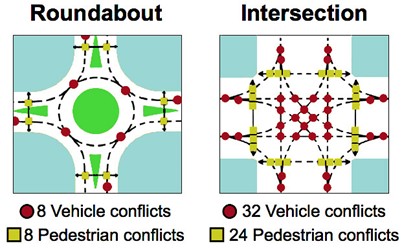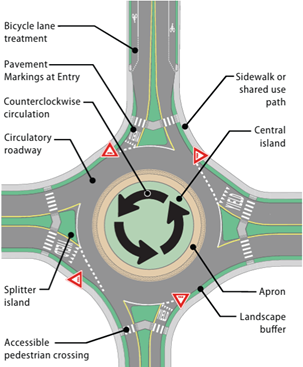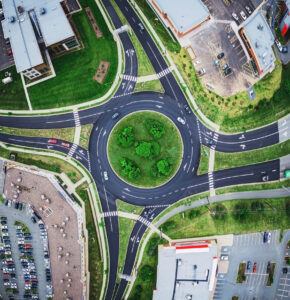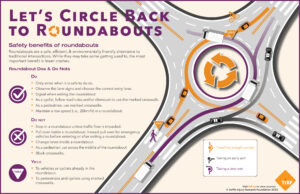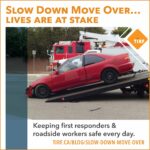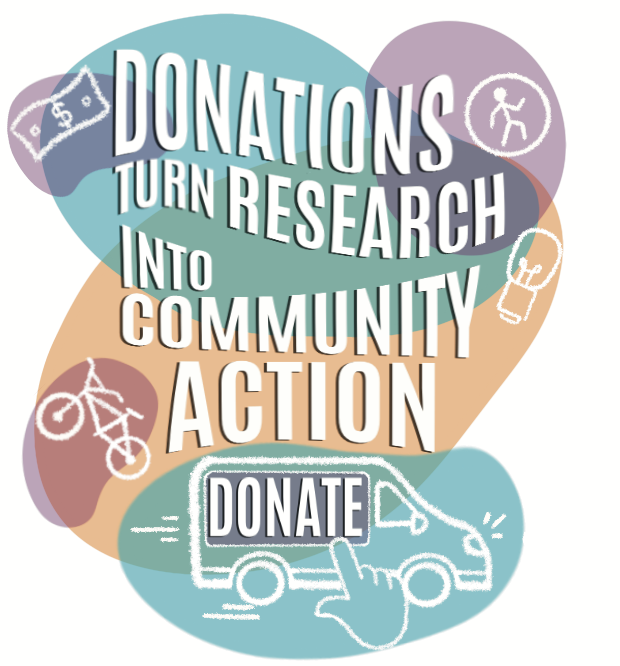Roundabouts are no longer a novelty on North American roads. They’ve become a common feature of modern traffic design. Since the early 1990s, communities have increasingly embraced them as a safer, more efficient alternative to traditional intersections that typically use stop signs or traffic lights. There are over 1,400 roundabouts across Canada and 11,000 in the United States with more being developed every year. Despite their growing presence, many drivers still view roundabouts as confusing or inconvenient simply because they aren’t as familiar with them.
Safety benefits of roundabouts
Did you know roundabouts are actually safer than traffic signals and stop signs? This is because roundabouts use curved approaches that reduce vehicle speed and oblige drivers entering it to yield right-of-way to vehicles already in the roundabout. The counterclockwise flow of traffic around a central island also minimizes conflict points (i.e., opportunities for collisions). An average 4-way stop intersection has 32 vehicle conflict points, but a roundabout has just eight. Lower speeds make it easier for drivers to yield to oncoming vehicle and pedestrian traffic because less stopping distance is needed. In addition, the circular shape greatly reduces the likelihood of angle or T-bone collisions which are common at intersections, and, thus, increase injury severity.
Source: https://www.flickr.com/photos/nextstl/9577583353
Roundabout design is also more protective of cyclists and pedestrians because typical speeds in roundabouts are 20-30km/h (or 13-18mph), at which active transportation users are more likely to survive in the event of a collision. There are also less pedestrian conflict points in a roundabout (8) compared to a 4-way intersection (24), decreasing opportunities for collisions.
When used correctly, roundabouts are generally safer for pedestrians. A Canadian research study found roundabouts are 30% safer for pedestrians compared to stop lights. Pedestrians use sidewalks around the perimeter and cross only one direction of traffic at a time. Crossing distances are relatively short and traffic speeds are lower than at traditional intersections as vehicles slow down to yield at the roundabout.
Where do roundabouts work best?
Roundabouts are appropriate at many intersections, including high-crash locations and intersections with large traffic delays, complex geometry (e.g., more than four approach roads), frequent left-turn movements, and relatively even traffic flow. Roundabouts can be built along congested arterials and at freeway exits and entrances to replace traffic signals.
Source: https://highways.dot.gov/safety/intersection-safety/intersection-types/roundabouts
Emergency services and roundabouts
We are likely all familiar with Slow Down and Move Over legislation across North America, which refers to drivers reducing their speed and changing lanes to provide a safe space to accommodate emergency service vehicles. While this feels simple on your average city or country road, how does it work in a roundabout? Your plan of action depends on whether you have entered the roundabout when the emergency vehicle approaches.
If you have not entered the roundabout:
- Pull over. Move your vehicle to the right-hand side of the road and stop. Stopping outside the roundabout prevents you from becoming an obstacle within it, providing emergency vehicles with a clear pathway.
- Wait. Allow the emergency vehicle to pass through the area before you proceed. Even if the roundabout looks clear, entering it could block the emergency vehicle or force it to navigate around you. Once the emergency vehicle has passed through the roundabout, check your mirrors and surroundings to ensure no more are on their way through before you proceed.
If you have entered the roundabout:
- Do NOT stop! Continue driving through the roundabout. Stopping inside the roundabout creates a hazard and blocks the flow of traffic, which can trap the emergency vehicle and prevent it from maneuvering effectively. Roundabouts rely on movement, so keep circulating.
- Exit normally. Head towards your intended exit, this clears space inside the roundabout quickly, keeping the route open for the emergency vehicle.
- Pull over. After exiting the roundabout, pull to the right and allow the emergency vehicle to pass. Once you’re on the straight road beyond the roundabout, it’s much safer to stop and give the emergency vehicle the right-of-way, providing the widest, most predictable path for them.
Myths & misperceptions about roundabouts
Myth? Roundabouts slow down traffic
False. Roundabouts actually improve traffic flow because vehicles are constantly moving in a single direction. This means there is less need for stopping and starting which slows you down on the way to your destination, and results in drivers speeding between traffic lights. Research has shown roundabouts can reduce traffic delays and stops by up to 74%. While some drivers might experience delays due to a lack of familiarity, the overall effect of a well-designed roundabout is improved traffic volume and less idling (which is also great for the environment!).
We’ve all witnessed the speeding, erratic, lane-changing driver racing from one intersection to another (yes, also extremely unsafe because roads are not racetracks) only to find them sitting beside you at the next set of traffic lights.
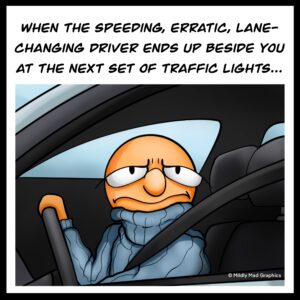
Myth? Roundabouts increase crashes
False. Roundabouts reduce crashes overall. This is assuming drivers yield right of way to oncoming traffic and travel at safe speeds. At intersections, the most severe types of crashes are T-bone, left turn, and head-on collisions. Roundabouts reduce opportunities for these types of crashes as well as the speed of impact; research shows a 78-82% reduction in severe crashes (meaning those resulting in an injury or loss of life).
Myth? Roundabouts accommodate fewer vehicles than other intersections
False. In fact, the volume of vehicles flowing through a roundabout is typically much greater and faster as compared to stop lights/signs. Intersections controlled by traffic lights require drivers travelling in two of the possible directions to stop while the other two flow through the intersection in a short, pre-determined duration of time.
Compared to a 4-way stop, roundabouts allow all drivers from all directions to advance consistently and much more quickly. Roundabouts also reduce the temptation to briefly engage with a phone while stopped at an intersection.
It may be counter-intuitive, but this is also why we see roundabouts at higher traffic locations and busy areas such as school drop-off zones because they can manage higher volumes of traffic more efficiently and safely.
Myth? Roundabouts are complicated to navigate
False. You just need to know how they work. A roundabout is based on the same premise as making a right turn from a stop sign which we’ve all done countless times.
At a traffic signal, a right-turning driver stops, looks for moving traffic coming from the left, glances both left and right for pedestrians and cyclists, chooses an acceptable gap (there are certainly wide differences in perception about what’s acceptable) in vehicle traffic, so they can complete their turn and enter the closest lane. Yes, the topic of gap acceptance and which lane of traffic to enter is a whole other issue…perhaps for another blog…but, the principle remains the same.
At a roundabout, the oncoming driver approaches the yield line, looks for oncoming traffic from the left, chooses an acceptable gap in the traffic flow, and then enters the roundabout with a right turn at the yield sign. Once in the roundabout, drivers continue circling counterclockwise until reaching the desired exit. And, unlike intersections, if you miss your turn, you get a do-over by simply circling again. Exit manoeuvres are also right turns.
A main difference is drivers signal a turn prior to coming to a stop at an intersection whereas in a roundabout drivers signal to indicate their intention to exit. Of course, it becomes a little more complex in roundabouts with two or more lanes because often the lane you’re in is an indication of where you intend to exit. Either way, use of the turn signal is important for other drivers to know your intentions regardless of whether you’re at an intersection or in a roundabout (or, let’s face it, just simply changing lanes on a highway). Generally speaking, whether you’re turning right at an intersection or exiting right in a roundabout (Ministry of Transportation Ontario; Province of British Columbia), you must use your turn signal.
Educating new and experienced drivers about roundabouts

While roundabouts are commonplace in many European countries, it’s still a relatively new phenomenon for North America. To fully reap the benefits of this road design, it’s important to integrate knowledge of roundabouts into new driver training. This not only prepares new drivers to navigate them safely but allows this information to be passed along to parents or guardians involved in the many hours of required practice. At the same time, education and awareness campaigns are important to ensure experienced drivers understand how to navigate them.
Many provincial governments feature sections on their websites or in their driver’s handbooks on road rules for roundabouts. Ensuring this information is also made widely available to drivers through awareness and education campaigns goes a long way toward the successful implementation of this effective road design.

Roundabout Dos & Do Nots
Do
- Only enter when it is safe to do so.
- Observe the lane signs and choose the correct entry lane.
- Signal when exiting the roundabout.
- Maintain a low speed (i.e., 20km/h) in a roundabout.
- As a pedestrian, use marked crosswalks.
- As a cyclist, follow road rules and/or dismount to use the marked crosswalk.
Do Not
- Stop in a roundabout unless traffic flow is impeded.
- Pull over inside a roundabout; instead pull over for emergency vehicles before entering or after exiting a roundabout.
- Change lanes inside a roundabout.
- Block crosswalks.
- As a pedestrian, cut across the middle of the roundabout.
Yield
- To vehicles or cyclists already in the roundabout.
- To pedestrians and cyclists using marked crosswalks.
Despite their many advantages, roundabouts can take some getting used to, and there are some common misconceptions about how they work. Overall, roundabouts are a safe, efficient, and environmentally friendly alternative to traditional intersections and are likely to become increasingly common as traffic planners continue to prioritize safety and sustainability in their designs. While they may take some getting used to, drivers can rest assured that navigating a roundabout is a road design consistent with other road designs and rules.
#MySafeRoadHome blog co-authors: Hannah Barrett, TIRF Researcher & Program Manager; Karen Bowman, Director, Communications & Programs (Drop It And Drive® program); and, Carl Wicklund, TIRF USA Senior Advisor, work collaboratively as co-authors. Hannah is a criminologist and specializes in alcohol ignition interlock programs, wildlife-vehicle collisions, and impaired driving countermeasures. Karen has led the DIAD program since 2010 which, to date, has been delivered to over 65,000 youth and workers across North America. She uses her writing and blogging background to help apply TIRF’s research to real-world driving. Carl previously developed and managed several community-based programs for justice-involved individuals, served as Court Services Director for a three-county community corrections system, was for 20 years the Executive Director of the American Probation and Parole Association, and more recently was Director of the Community Justice Division of Volunteers of America – Minnesota/Wisconsin.
Related topics:
|
|
Source documents and resources:
Traffic Injury Research Foundation. (May 2024). Slow down move over… lives are at stake [Blog post]. TIRF #MySafeRoadHome. https://tirf.ca/blog/slow-down-move-over/
Brilon, W. (2011, May). Studies on roundabouts in Germany: Lessons learned. In 3rd International TRB Conference on Roundabouts, Carmel, Indiana. https://www.ruhr-uni-bochum.de/verkehrswesen/download/literatur/Brilon_roundabouts_2011_05_29_cit.pdf
Daniels, S., Brijs, T., Nuyts, E., & Wets, G. (2010). Explaining variation in safety performance of roundabouts. Accident Analysis & Prevention, 42(2), 393–402. https://www.sciencedirect.com/science/article/abs/pii/S0001457509002280
Insurance Institute for Highway Safety. (2022, June). Roundabouts. https://www.iihs.org/topics/roundabouts
Miyake, R., & Fu, L. (2025). Geometric design and safety outcomes of roundabouts in the Canadian context: A case study in the region of Waterloo. Canadian Journal of Civil Engineering, 52(5), 907–915.
National Academies of Sciences, Engineering, and Medicine. (2022). Highway safety manual user guide. The National Academies Press. https://doi.org/10.17226/26552
Sakshaug, L., Laureshyn, A., Svensson, Å., & Hydén, C. (2010). Cyclists in roundabouts—Different design solutions. Accident Analysis & Prevention, 42(4), 1338–1351. https://www.sciencedirect.com/science/article/abs/pii/S0001457510000606
Weber, P. (2007). Roundabout safety experience—Chapter 5 of the synthesis of North American roundabout practice. In 2007 Annual Conference and Exhibition of the Transportation Association of Canada: Transportation—An economic enabler (Les transports: un levier économique). Transportation Association of Canada.
